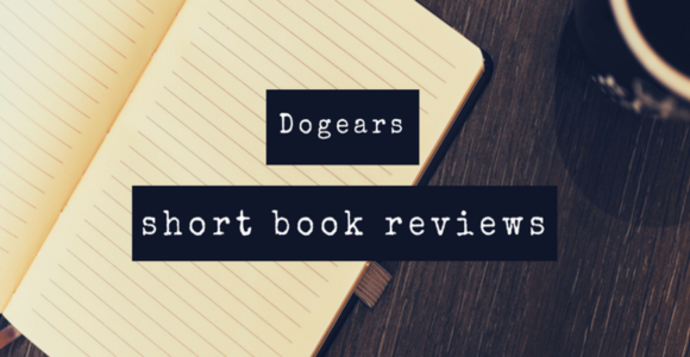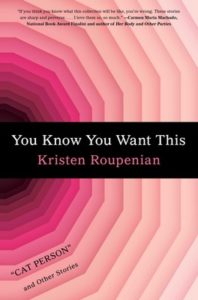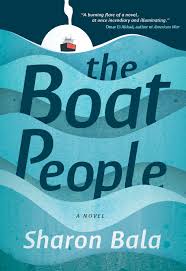In a world filled with far too many great books, it’s hard to figure out what to pick up next. Luckily, Bookmarked is here to help in your search with “Dogears,” bite-sized book reviews from our growing TBR piles. Check out what we’ve been reading this past month, and see if you can find your next favorite read!
You Know You Want This
Kristen Roupenian
Gallery Books
January 15, 2019
Reviewed by Christa Seeley
Like so many others, I remember getting caught up in the “Cat Person” excitement when the story was published by the New Yorker back in 2017. At first glance, a short story about a 20-something college student and her flirtation with an older man doesn’t seem like something that would go viral. But it did what all good stories do: it sparked a conversation. A conversation about sex, gender politics, and power dynamics.
So when I heard Roupenian would be releasing her first short story collection in 2019, I knew I needed to get a copy. I hoped it would be full of engaging well-written stories like “Cat Person,” and for the most part, it delivered. The stories in You Know You Want This show a darker side of humanity and dissect the different power dynamics we may encounter in our lives—both toxic like in “Bad Boy” where a couple begins manipulating their single friend, and shifting like in “Biter” about a young woman with a love of biting who is waiting for the opportune moment to clamp down on her co-worker.
As you may be able to tell, there is often a violent or grotesque slant to the stories and even a few moments that are hard to read (pro tip: do not read “The Matchbox Sign” before bed). Sometimes they even walk the line into the supernatural. They weren’t all standouts, however. Some were much weaker than others, like “Sardines” or “The Mirror, the Bucket and the Old Thigh Bone.” But all of them made me pause and take a moment to digest what Roupenian was trying to say.
You Know You Want This is a collection of stories about women, about how women carry themselves, how they make decisions, and how others interact with them. And even though I didn’t love all of the pieces as much as “Cat Person,” I was impressed with the collection. If you’re a fan of writers like Kelly Link and Carmen Maria Machado, I think you will be impressed by Roupenian too.
The Brilliant Death
Amy Rose Capetta
Viking
October 30, 2018
Reviewed by Emily Lauer
The Brilliant Death is a YA high fantasy with a queer romance and a lot of court intrigue. In it, Teodora is the odd second daughter of one of the Five Families. Her father is feared and respected, her older sister and stepmother are both beautiful, and Teo herself has a powerful secret: she is a Strega, a magic user. Teo has the power to turn things into other things, and mostly uses it to privately transform into inanimate objects against men who have wronged her family. Her family thinks fate is looking out for them because their enemies keep disappearing, and Teo’s bedroom is quite ornamented. Then Teo meets Cielo, a much more knowledgeable young Strega who is a shapeshifter. Cielo is sometimes a beautiful young man, sometimes a beautiful young woman, sometimes not in human form at all.
Capetta’s prose is lush and the plot gallops along, with deft characterizations complicating each new revelation about the politics, magic, and relationships that surround our two main characters. When a political strike injures Teo’s father, some of the family is called away. Teo and Cielo’s romance blossoms on the road, as Teo learns more magic and readers learn more about this fantasy world based on Italian history. By the time they get to the court where much of the action happens, I found it difficult to put the book down to sleep or eat. It has an anticipated sequel that will conclude the story in 2020.
The Marrow Thieves
Cherie Dimaline
Dancing Cat Books
April 1, 2017
Reviewed by Wendy Browne
I discovered this book as a library app recommendation, and I am now thrilled to learn that it’s being adapted for television. This young adult story takes place in a dystopian future and, at first glance at the blurb, it might seem like any other YA dystopian novel. But this is so much more. The concept is that, following some strange illness and the ravages of global warming, people have lost the ability to dream and the result is madness. I mean, we know this can happen. We’ve seen Star Trek: The Next Generation’s “Night Terrors” episode. But it’s not eyes in the dark; one moon circles that will cure this ailment. It’s the lifeblood of Indigenous people—the only people left in the world who have not lost their connection to the dreamscape because, despite all efforts by the world around them throughout the ages, they have never lost their connection to each other and to their heritage.
As a young boy named Francis and a band of survivors try to make their way to safety while evading the recruiters, Dimaline takes every opportunity to share the rich depth of culture and resilience of a persecuted people. No matter what tribe they are from, they are bound together now as they seek to stay away from the “schools.” And the fact that the marrow factories are referred to as “schools” is not even a remotely subtle callback to the residential schools where Indigenous children, torn from their homes, were brutally forced to assimilate into a culture that continues to abuse and cast them aside.
This is a painful story, but one that needs to be told from this perspective. Because, despite the pain, Francis and his companions display the true meaning of hope, found family, and survival, no matter the cost.
Bad with Money
Gaby Dunn
Atria Books
January 1, 2019
Reviewed by Paige S. Allen
One of my New Year’s Resolutions for 2019 was to, if I may be crude, get my shit together and finally develop smart financial habits for my future. It’s a daunting goal, I know, but Bad with Money has been a pretty good jumpstart for me into this lifelong research. Based on her popular podcast of the same name, Dunn shares a wealth of important tips and interesting considerations about money through autobiographical anecdotes, external interviews, and lots of expert data.
And I don’t say wealth just to be punny: this really is an expansive little book of information, discussing some of the best financial decisions one can make at any age. The only negative about this wide focus is that many early chapters about high school and college savings don’t really help me at age 25. I wonder if this is the kind of book I would even have picked up when I was younger, especially since the marketing for this book is aimed at more mature audiences. But retroactively regretting how I spent my late teens and early twenties is a minor discomfort for all the great tips that are more relevant to my current life stage. These kinds of tips deal with how to build your credit score, tackle student loans, save for retirement, and start planning for big expenditures like funding your wedding or buying your first home.
What makes Bad with Money especially useful at the start of one’s financial planning journey is how nonjudgmental, relatable, and inclusive it is. Dunn has spent a lifetime with her own financial troubles, first influenced by her parents’ behaviors and further aggravated by a stagnant national economy, career aspirations in the notoriously low paying entertainment industry, and her bipolar disorder. She thus comes to the money discussion with compassion for people’s baggage, whether it be emotional or systemic. The care Dunn takes in including the additional burdens that people marginalized across race, gender, class, and physical and mental ability face in establishing long-term financial stability and success is part of this refreshing compassion, and it is also greatly appreciated in an industry otherwise plagued with generalized advice that is, in truth, best suited for already economically privileged or supported individuals. For this and so many other reasons, I know this is the book I will cherish on my bookshelf and recommend to everyone I know for the rest of my life.
Her Body and Other Parties: Stories
Carmen Maria Machado
Graywolf Press
October 3, 2017
Reviewed by Melissa Brinks
I had read and loved “The Husband Stitch” before diving into Her Body and Other Parties: Stories, but I didn’t expect how thoroughly this book would sink into my bones. In this collection of short fiction, Carmen Maria Machado explores themes of femininity, queerness, sex, and horror, all of them woven together in strange and thrilling ways.
Machado is as gifted as any writer past or present; her work is so thoroughly terrifying, so grounded in reality, yet so wonderfully strange that I can’t stop thinking about it weeks later. Every book I’ve read after it has the unfortunate task of trying to measure up to its perfect straddling of speculative fiction and realism, which is a feat for a book that contains post-apocalyptic stories alongside Law and Order: SVU fanfiction alongside Angela Carter-esque explorations of the sheer power and terror of being a woman.
I am happily haunted by Her Body and Other Parties, and I look forward to reading and being consumed by it again in the future.
The Boat People
Sharon Bala
Doubleday
January 9, 2018
Reviewed by Louis Skye
The Boat People follows a group of Sri Lankan refugees as they arrive in Vancouver, Canada, seeking asylum in the country. It’s a really hard-hitting and evocative story that fascinated and saddened me while reading it. I didn’t know this before reading it, but The Boat People is based on the true story of 500 Sri Lankan refugees who arrived by boat in Canada in 2010.
Author Sharon Bala chooses to fictionalise the story of some of those involved with the real refugees’ arrival—Mahindan, a refugee who has been separated from his son, Salim; Priya, a law student who is bamboozled into working the refugees’ cases because of her Sri Lankan background; and Grace, the adjudicator of the cases who strongly believes that some of the refugees are a danger to the country and should be deported. Through these central characters, we see lives unfold, futures made, and dreams destroyed.
The Boat People is a gripping read, mainly because of how Bala ekes out the facts of Mahindan’s case and the various motivations for both Priya and Grace. I like that none of the characters are as pure as driven snow. In fact, they all have remarkable flaws and, at different points of the story, are even close to unlikeable. People aren’t perfect, so why should characters be?
I do wish the ending wasn’t as open-ended as it was, mainly because I really wanted to know what would happen to the characters. But it is well-written nonetheless. I’m not sure whether Bala is planning a sequel— if she is, that would be great—but even if this is all we know about Mahindan, Priya, and Grace, I think this is a fantastic, heart-breaking, and fulfilling story.







